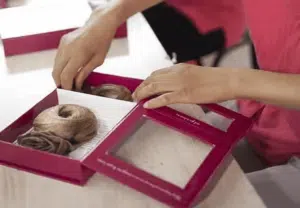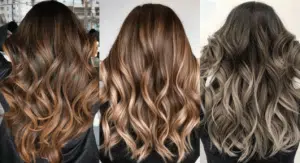Clients want instant length that looks natural and installs in seconds. Wrong length ruins blending and comfort. The right length gives perfect proportion and repeat sales.
To choose the correct halo hair extensions length, confirm the client’s base length, height, face shape, density, and styling habits. Measure from crown to desired endpoint, match weight to density, then fine-tune fit with wire and combs for a seamless fall.

This guide explains what a halo is, standard halo extension lengths, how to measure, how it should sit, who it suits, and how to prevent slipping. Share it with stylists and retail teams to standardize consultations.
What are Halo Hair Extensions?
Clients often confuse halos with clip-ins. You must define the system before you size it.
A halo is a single, wide weft mounted on a thin, transparent wire that sits like a headband around the crown. The weft rests below the occipital bone while the client’s own hair is combed over to hide the wire. Most pro halos come in lengths from 16–30 inches, with adjustable micro-beads or notches to tune the wire.
Dive deeper
The halo system removes pressure from fragile areas because it does not use beads, glue, or tapes. It relies on distribution. The wire carries the weight across the parietal ridge, and the weft spreads weight along the nape and mid-occipital. This makes halos ideal for clients who want fast transformation without commitment. I use full cuticle, single-donor hair for halos because the fiber must tolerate frequent on/off cycles and brushing. Cuticle alignment reduces frizz and keeps the ends clean even in longer lengths like 26–30 inches.
We suggest stock three density tiers: Light (80–120g) for fine hair, Medium (140–180g) for average density, and Full (200–240g+) for thick or long goals. The wire hardware matters. A clear mono-filament wire looks invisible under salon lighting, while a fabric-coated wire can give more grip for very silky hair. Many halos now include two small, pressure-free security combs at the temples or center back. I use those combs only as an assist, not as primary support. The wire should do the work. In retail boxes, I include an extra wire, crimp beads, and a fit card so the stylist can complete adjustments in minutes.
| Spec | Typical Options | Selection Note |
|---|---|---|
| halo extension lengths | 16″, 18″, 20″, 22″, 24″, 26″, 30″ | 16–22″ for most; 24–30″ for tall or dramatic |
| Density (grams) | 80–240g | Match density to client’s natural fullness |
| Wire type | Clear mono / fabric-coated | Clear looks invisible; fabric adds micro-grip |
| Base width | 8–11 inches | Wider base = better distribution |
What Length Halo Hair Extensions Should I Get?
Clients ask this first. A clear rule avoids returns. Right length depends on base length, height, and styling goals.
Most clients look balanced when the halo is 4–6 inches longer than their natural hair. Petite clients look best at 16–20″. Average height suits 18–22″. Tall clients or dramatic looks can go 22–26″+. Always match density to natural fullness for believable lines.
Dive deeper
Start with a mirror consult. Ask the client to stand straight, hair natural, no high shoes. Identify the base line: the longest point of their current perimeter. Decide the target line: around bust, rib, waist, or hip. Measure from crown (high point) down the back to the target with a soft tape. That crown-to-end measurement corresponds to retail length labels. For wavy or curly textures, add 1–2 inches because lengths are measured stretched straight.
Height changes perception. A 20-inch halo on a petite client may feel waist-length, while the same on a tall client looks like mid-back. Face shape matters too. For round or heart-shaped faces, 18–20″ with face-framing tends to lift and elongate. For oval or oblong faces, 20–24″ balances features well. Lifestyle matters. Daily gym users handle 16–20″ more easily. Photoshoot or bridal clients can manage 22–26″ for impact. If the client’s natural hair is at collarbone and very fine, a light-to-medium density at 18–20″ blends better than a heavy 24″. Heavier grams without enough natural density create a shelf.
| Natural Length | Go-To Halo Length | Height Guide (Quick) | Density Guide |
|---|---|---|---|
| Bob (chin–jaw) | 16–18″ | Petite: 16–18″ | Average: 18–20″ |
| Lob (shoulder) | 18–20″ | Petite: 16–18″ | Average: 18–22″ |
| Collarbone | 18–22″ | Petite: 18–20″ | Average: 20–22″ |
| Mid-back | 22–26″ | Petite: 20–22″ | Average: 22–24″ |
Use these rules to select confidently and to reduce returns. Mention “halo extension lengths” in your product pages to help clients filter.

How to Measure for a Halo?
Incorrect measurement causes brassy reviews and exchanges. Good measurement locks in the sale.
Measure from the crown to the desired endpoint on the back. Then cross-check from nape to perimeter to confirm blend. For fit, measure the wire path around the crown: front hairline, over ears, and around occipital, then adjust until snug but not tight.
Dive deeper
Take three measurements. First, Crown-to-Goal: place the tape at the highest point of the head where the wire will sit, then run it down the back to the target line. Match this to the labeled length. Second, Nape-to-Perimeter: place the tape at the nape and measure to the current perimeter. If this gap is more than 6–8 inches, plan for layering or consider stepping down a length for better blending. Third, Wire Path: mimic the halo route around the head. The wire should sit one to two fingers behind the hairline, pass over the parietal ridge, and rest under the occipital. Mark that path with a soft measuring tape. Most adjustable wires have crimp beads or knots. Set the wire so that when the client shakes, the halo stays still, but when they open their mouth wide or raise brows, there is no pinch.
we suggest clients to tilt forward and shake gently. If the halo migrates, shorten the wire by one notch or add micro-silicone sleeves to increase grip. For very silky hair, a light dusting of texturizing powder along the wire path can help. For clients with high crowns or flatter occipitals, test two positions: slightly higher for volume, slightly lower for perimeter weight. Finalize by combing the top veil of natural hair over the wire. If the veil is too thin, add a soft backcomb at the parting to mask the line.
Where Should a Halo Sit on the Head?
Wrong placement causes headaches, slipping, and visible wires. Correct placement disappears in seconds.
A halo should sit one to two fingers behind the front hairline, pass above the ears on the parietal ridge, and anchor under the occipital bone. The weft should hug the head’s curve without gaps, with a full veil of natural hair covering the wire.
Dive deeper
Think of the head in three zones. Zone A: the front veil. It must be long and dense enough to cover the wire when combed back down. If the client has a very high recession or baby-fine hairline, recommend a slightly lower placement plus soft teasing at the part to maximize veil coverage. Zone B: the parietal ridge over the ears. The wire should rest on bone, not soft temple tissue. Bone contact spreads weight and increases stability. If the wire sits too forward on soft tissue, it digs and slides. Zone C: the occipital shelf. The weft should sit just under the bump so gravity keeps it parked. Too low and it collides with collars. Too high and it pops when the client looks down.
Fitting tips: ask the client to nod, then turn side to side. The halo must stay planted. If it creeps backward, shorten the wire slightly. If it pinches, lengthen a notch. If the top veil splits and shows the wire, add a subtle zig-zag part or micro backcomb. For clients with a flat back-of-head, consider a halo with a slightly curved base for better contour. Some models include small temple combs. Use them gently, aimed backward into the veil, to avoid lifting the front veil when the client moves.

Do Halo Extensions Fall Out Easily?
Clients fear the “fall-off” moment. Proper fit eliminates that fear.
No, a correctly fitted halo does not fall out easily. Slipping happens when the wire is too long, the placement is too forward, the veil is too thin, or the hair is ultra-silky with zero grip. Adjust the wire, shift the placement, and add micro-grip to fix it.
Dive deeper
Start with the shake test. With the halo on, ask the client to look down and gently shake. If the halo slides, shorten the wire one stop. If it rides up, lengthen it. Show the client the tilt-removal technique: lift the back veil slightly, hook a finger under the wire at the occipital, and tilt forward to release. This shows control and reduces anxiety.
For ultra-silky hair, add three micro-strategies. First, light texturizing powder or a soft tease under the wire path adds traction. Second, use the included temple or center-back comb lightly as insurance, not as the main support. Third, teach the client to avoid heavy oil sprays at the crown. Oils reduce friction and invite sliding. For heavy density halos (200g+), ensure the base width is wide enough to spread weight. A narrow, heavy halo creates a focal point that moves. Wider bases stay put.
A halo is perfect for daily wear at the office, nights out, and events. For intense activities—hot yoga, sprint work, tumbling—the halo is not the best tool. Advise clients to remove it for sport and reapply after. That clarity prevents complaints and keeps reviews clean.
How to Blend and Style a Halo for Perfect Lines?
The wrong cutting approach exposes the shelf. The right approach erases the line.
Blend by dry-cutting the halo on the client while worn. Establish face-framing, break the perimeter with deep point-cuts, and add interior weight removal to match the client’s density. Style with bevel at the ends to unify textures.
Dive deeper
It is suggested that always cut halos on-head because gravity matters. Start with face-framing that links the client’s front veil to the halo’s front edges. Use vertical sections and point-cuts for softness. For lob-length bases stepping to 20–22″ halos, add internal layers to avoid the classic shelf. On fine hair, avoid heavy, short layers that thin the perimeter. Instead, use interior slide-cutting to blur weight without losing fullness at the ends.
Heat mapping is simple. Polish with a round brush or a hot brush to bend the last three inches. This bevel hides length junctions. For curls, wrap both the natural hair and halo hair together in the same iron pass so patterns match. Finish with a light hold spray at mid-lengths. Keep oils away from the crown. If the client likes center parts, add a discreet micro-teeze under the part to protect the wire line. For side parts, check both sides for symmetry since the halo is symmetrical but the head is not.
| Blend Goal | Technique | Result |
|---|---|---|
| Erase shelf | On-head point-cuts + interior slide cutting | Seamless transition |
| Add movement | Long layers starting below the chin | Natural swing |
| Match curl pattern | Curl natural + halo together | One pattern, no separation |
| Keep ends full | Minimal perimeter thinning | Luxurious finish |
My Opinion
From a manufacturer’s view, halos are the most profitable retail extension for salons. They require no install slot, they drive instant makeovers, and they avoid adhesive education. The key is curation: stock the three most-requested lengths (18″, 20″, 22″) in two densities and two bases (regular and deluxe wide). Add limited 24–26″ for tall or high-impact clients. Always ship with a second wire, crimp beads, and a step card. Train your team to size by base length, height, density, and lifestyle. This reduces returns and turns one-time buyers into repeat customers.
FAQ
What are standard halo extension lengths?
Most lines offer 16″, 18″, 20″, 22″, 24″, 26″, and sometimes 30″.
How do I choose between 18″ and 20″?
If the client is petite or wants everyday ease, pick 18″. For average height or more drama, pick 20″.
Can halos work on short bobs?
Yes, with careful blending. Often 16–18″ with internal debulking gives the cleanest result.
Do halos damage hair?
No. There is no adhesive or bead. The wire distributes weight across the head.
Can clients wear halos daily?
Yes. Advise removal for sports and sleeping. Store on a hanger or silk bag.
Will a halo show in wind?
Not if the veil is adequate and the wire path is correct. Use a micro backcomb on very fine crowns.
How long does a halo last?
Full cuticle halos last 9–18 months with proper care and gentle brushing.
Can clients curl and straighten a halo?
Yes, if it is 100% human hair. Use heat protectant and moderate temperatures.
What gram weight should I stock?
Light/Medium (140–180g) for most clients. Full (200–240g) for thick hair or 22–26″ lengths.
Do I need temple combs?
Use them lightly as insurance. The wire should carry the load.
Conclusion
Select halo length by base length, height, and density. Measure crown-to-goal, fit the wire snug, seat under the occipital, and blend on-head. Correct length and fit create seamless, secure results.
Hibiscus Hair Manufacturer has been dedicated to producing high-quality hair extensions for 25 years and is a recognized leader in the industry. If you are interested in finding a reliable hair extensions supplier and wholesale for your brand, please visit our website for more information:
Halo Hair Extensions





